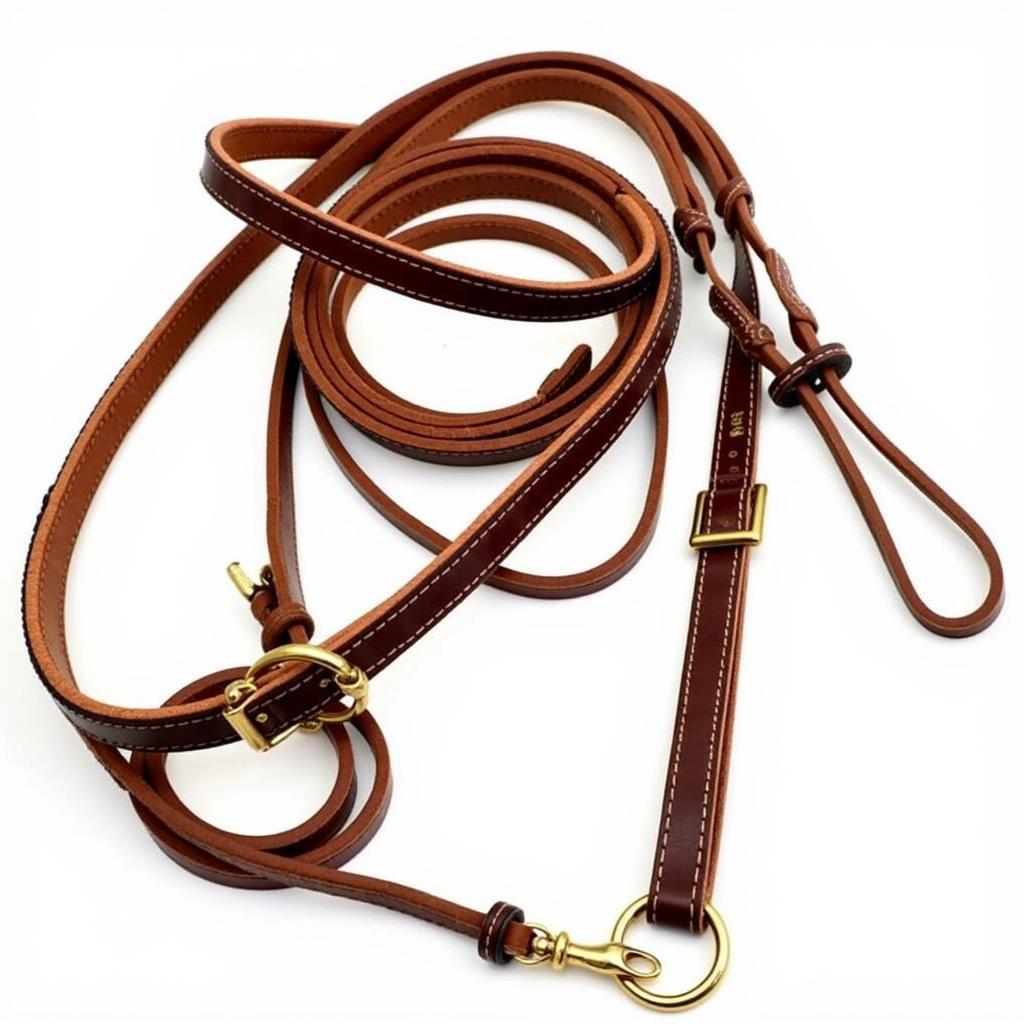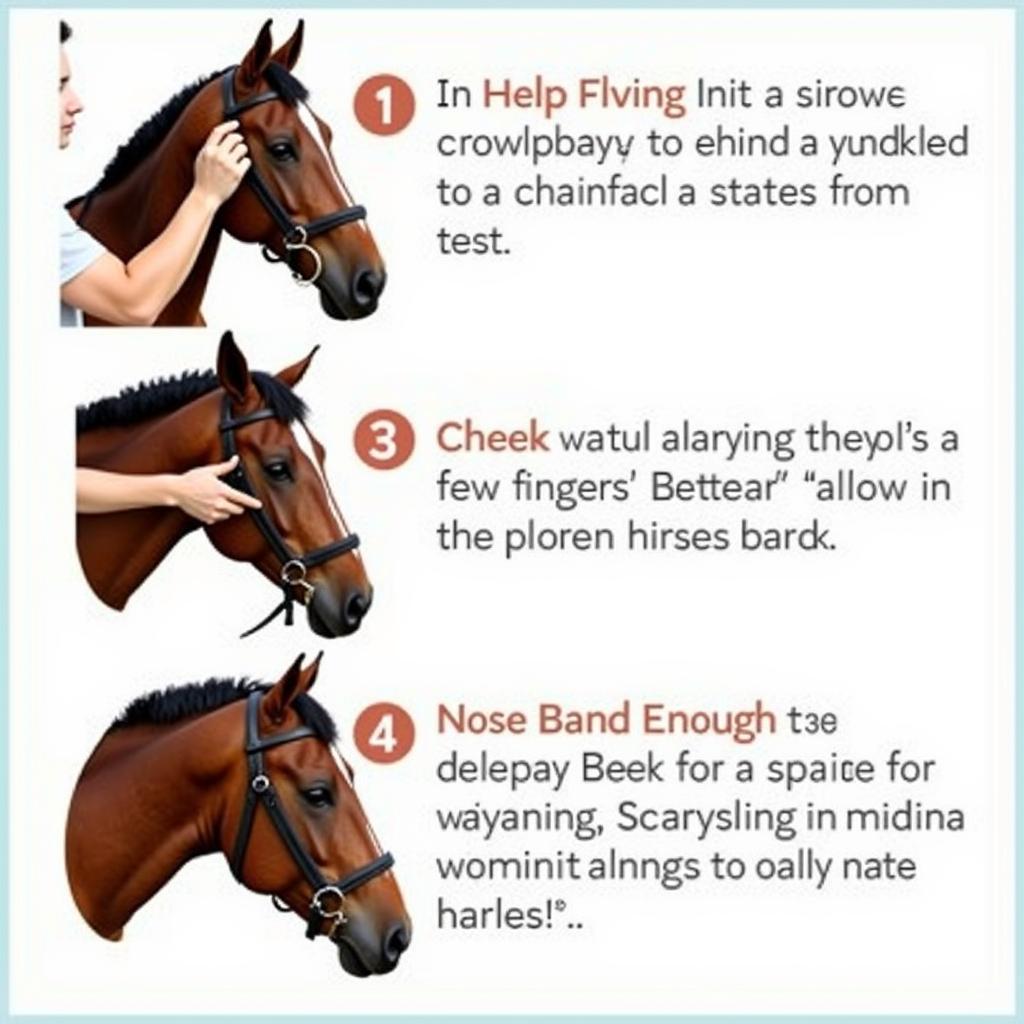A Horse Halter With Lead Rope is a fundamental piece of equipment for any horse owner. It’s the primary means of control and communication, essential for leading, tying, and handling your horse safely. Choosing the right halter and lead rope can significantly impact your horse’s comfort and your overall handling experience. Let’s delve into the world of horse halters and lead ropes, covering everything from choosing the right materials to proper fitting techniques.
Choosing the right horse halter with lead rope depends on various factors, including your horse’s size, temperament, and the intended use. Materials, construction, and fit play a crucial role in ensuring both safety and comfort for your equine companion. From everyday handling to training and showing, understanding the nuances of these essential tools will elevate your horsemanship. A well-fitted halter and lead rope are not just about control; they’re about building trust and communication between you and your horse. After the introduction, we will cover the different types of horse halters, from leather to nylon, and discuss their specific advantages. We’ll also guide you through choosing the correct lead rope length and material.
You can find a wide variety of horse halters and other accessories at our horse accessories online store.
Types of Horse Halters
Different disciplines and activities often call for specialized equipment. Understanding the various types of horse halters available can help you make informed decisions.
Leather Halters
Leather halters are known for their durability, classic appearance, and the ability to develop a beautiful patina over time. They are often preferred for showing and everyday use. However, they require regular cleaning and conditioning to maintain their quality.
Nylon Halters
Nylon halters are a popular choice due to their affordability, ease of cleaning, and wide variety of colors. They are lightweight and resistant to weathering, making them ideal for everyday use, especially in challenging weather conditions.
Rope Halters
Rope halters are often used in training and groundwork. They offer more precise communication through pressure points and can be effective in teaching a horse to yield to pressure. However, they require careful and skilled handling to avoid causing discomfort or injury to the horse.
 Leather Horse Halter with Lead Rope
Leather Horse Halter with Lead Rope
Choosing the Right Lead Rope
The lead rope is just as important as the halter itself. A proper lead rope should be comfortable to hold, durable, and the appropriate length for the intended use.
Lead Rope Materials
Lead ropes are typically made from materials like cotton, nylon, or leather. Cotton leads are softer and gentler on the hands, while nylon leads are stronger and more resistant to wear and tear. Leather leads, like leather halters, offer a classic look and durability but require more maintenance.
Lead Rope Length
Standard lead ropes are typically between 8 and 12 feet long. Longer lead ropes are useful for lunging or groundwork, while shorter leads are preferred for leading and tying. Consider a horse lunging line for lunging exercises.
How to Properly Fit a Horse Halter
A properly fitted halter is essential for your horse’s comfort and safety. A halter that is too loose can easily slip off, while a halter that is too tight can restrict breathing and cause discomfort.
Adjusting the Halter
Most halters have adjustable straps at the crownpiece, cheek pieces, and noseband. The crownpiece should sit comfortably behind the horse’s ears, and the cheek pieces should allow for two to three fingers’ width between the halter and the horse’s cheekbone. The noseband should be snug but not tight, allowing for two fingers to fit comfortably beneath it.
Checking for Proper Fit
Once the halter is adjusted, check for proper fit by ensuring the halter doesn’t slip easily over the horse’s head and that the noseband doesn’t ride up into the horse’s eyes. The throatlatch should not be so loose that the horse can get a hoof caught in it. You might be interested in exploring other essential horse equipment such as rings for horses.
 Fitting a Horse Halter Correctly
Fitting a Horse Halter Correctly
“A well-fitted halter is the foundation for safe and effective horse handling,” says renowned equine behaviorist, Dr. Amelia Carter. “It’s about finding the balance between secure control and comfortable freedom for the horse.”
Caring for Your Horse Halter and Lead Rope
Proper care and maintenance will extend the life of your horse halter and lead rope.
Cleaning and Conditioning
Leather halters and lead ropes should be cleaned regularly with saddle soap and conditioned with leather conditioner. Nylon halters can be washed with mild soap and water.
Storage
Store your halters and lead ropes in a clean, dry place to prevent mold and mildew. Avoid storing them in direct sunlight, as this can cause the materials to fade or become brittle.
You can improve your horse’s fitness with tools like a horse exercise ball.
“Investing in quality halters and lead ropes, and caring for them properly, is a testament to your commitment to your horse’s well-being,” adds Dr. Carter. “It’s a small detail that makes a big difference in the long run.”
Conclusion
Choosing the right horse halter with lead rope is a crucial aspect of responsible horse ownership. By understanding the different types of halters and lead ropes available, and by learning how to properly fit and care for them, you can ensure the comfort, safety, and well-being of your equine companion. A good understanding of horse show terminology is also essential for every horse owner.
FAQ
- What is the best material for a horse halter? The best material depends on the intended use. Leather is durable and classic, nylon is affordable and easy to clean, and rope is good for training.
- How do I know if a halter fits my horse correctly? A properly fitted halter should be snug but not tight, allowing for two fingers’ width beneath the noseband and cheek pieces.
- How often should I clean my horse’s halter? Clean leather halters regularly with saddle soap and conditioner. Nylon halters can be washed as needed with mild soap and water.
- What length of lead rope should I use? Standard lead ropes are 8-12 feet long. Longer leads are used for lunging, shorter for leading and tying.
- Can I leave a halter on my horse overnight? Generally, it’s not recommended to leave a halter on overnight due to the risk of entanglement.
- What are the different types of lead ropes available? Lead ropes are typically made of cotton, nylon, or leather, each offering different benefits.
- How do I teach my horse to lead with a halter? Patience and positive reinforcement are key. Start with short sessions and reward your horse for following your lead.
For further assistance, please contact us at Phone Number: 0772127271, Email: [email protected] Or visit our address: QGM2+WX2, Vị Trung, Vị Thuỷ, Hậu Giang, Việt Nam. We have a 24/7 customer service team.